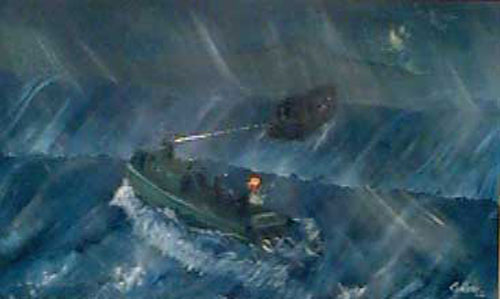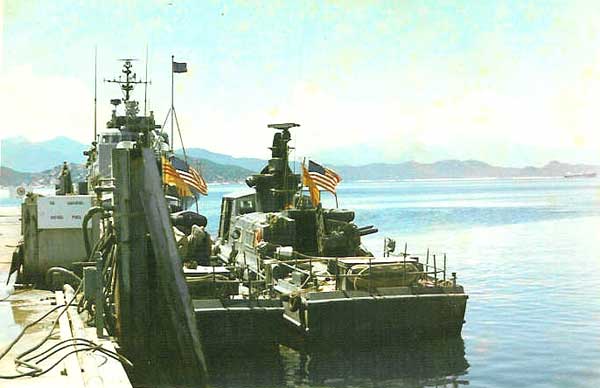 |
SwiftVets.com
Service to Country
|
| View previous topic :: View next topic |
| Author |
Message |
SBD
Admiral
Joined: 19 Aug 2004
Posts: 1022
|
 Posted: Wed May 25, 2005 5:15 am Post subject: Market Time sailors intercepted weapons on South Vietnam Posted: Wed May 25, 2005 5:15 am Post subject: Market Time sailors intercepted weapons on South Vietnam |
 |
|
Navy Times
April 14, 2003 Monday
Market Time sailors intercepted weapons on South Vietnam coast
By Robert F. Dorr; Special to the Times, Naval Historical Center
The rugged South Vietnamese coastline stretching for more than a thousand miles was the "beat" for American sailors who fought for seven years against enemy infiltration of supplies and weapons.
Operation Market Time was crucial to the Vietnam War but attracted little attention from the U.S. Congress, press or public. The seven-year effort to halt North Vietnam's seaborne smuggling of arms and supplies was carried out by an extraordinary mix of flying and floating weaponry - P-2 Neptune and P-3 Orion patrol planes, P-5 Marlin flying boats, Swift patrol boats, destroyers, radar picket escorts, gunboats, minesweepers, Coast Guard cutters and even a pair of experimental hydrofoil gunboats.
The effort to halt the smuggling started early in the U.S. involvement in Vietnam. Beginning in February 1962, Navy ships looked for North Vietnamese infiltrators and assisted the South Vietnamese navy in intercepting them. Soon after, the Navy embarked on Operation Beef-up, which broadened U.S. and South Vietnamese efforts to halt the flow of materiel by sea.
In February 1965, an Army pilot spotted a camouflaged ship at Vung Ro Bay on South Vietnam's central coast. Air strikes and a seaborne assault led to the discovery of more than 4,000 rifles and machine guns and thousands of cases of ammunition. The Vung Ro incident seemed to demand that the effort against seaborne infiltration become larger and better coordinated.
Market Time began in March 1965. On July 31, the operation was transferred from 7th Fleet to the Naval Advisory Group, Vietnam, initially under Rear Adm. Norvell G. Ward. The boats and ships that carried out the operation became the Coastal Surveillance Force, also called Task Force 115.
Ward also was commander, Naval Forces Vietnam - meaning, among other things, that the top sailor in country was also responsible for riverine operations. Half a dozen men held the job as the war progressed. The best-known was Vice Adm. Elmo R. Zumwalt Jr. from 1968 to 1970, a future chief of naval operations ["Zumwalt led Navy throughout controversial time in Vietnam," Damn the Torpedoes! Jan. 15, 2001].
There were many operations related to Market Time carried out by sailors. Operation Sea Dragon was the Navy's campaign against small enemy craft in the littorals north of the 17th Parallel, while Operation Game Warden concentrated on the rivers. Operation Andang tested the feasibility of Swift boats for anti-infiltration duties, sending two of the PCFs on a 1,000 journey from one end of the South Vietnamese coast to the other. The test produced mixed results, but Swift boats became an important tool in the effort to prevent North Vietnamese vessels from slipping ashore with supplies and weaponry.
As the United States built up its forces in Vietnam, Market Time gathered tempo. At the height of the U.S. commitment, Market Time sailors were intercepting a potential enemy vessel once per minute during daylight hours and frequently at night.
Between January 1966 and June 1967, U.S. and South Vietnamese patrol sailors inspected or boarded more than 700,000 vessels. During the peak of operations in 1968, U.S. and South Vietnamese vessels along the coast fired almost a million rounds of ammunition.
Beginning in 1967, the Coast Guard committed 15 high-endurance cutters to the Market Time mission, each armed with a 5-inch gun, six .50-caliber machine guns and two 81 mm mortars, while the Navy's Asheville-class patrol boat also made its debut. The 165-foot Ashevilles carried a 3-inch gun forward, a 40 mm cannon aft and various other weapons, and were capable of almost 40 knots, a powerful weapon against infiltrators ["Small Asheville-class gunboats had an international presence," Damn the Torpedoes! July 23, 2001.]
Former Coast Guard Engineman 3rd Class Darrell King, 53, of Coos Bay, Ore., was on the 255-foot cutter Wachusett (WHEC 44) in 1968 and 1969. "High endurance cutters were quite suitable [for this mission]," King said in an interview. "We were armed similarly to a destroyer escort but only drew about 16 feet of water as compared with 22 feet for a DE, so we could maneuver closer to shore. During gunfire support, which was part of Market Time, we could get about a mile closer to shore than a DE could. This meant we could be three or four miles offshore and our 5-inch gun could really reach out."
Much of the enemy's smuggling was done by small sampans and junks, but in 1969 and 1970, after political changes made the port of Sihanoukville, Cambodia, unavailable to the North Vietnamese, sailors in Market Time began to see large trawlers along the Vietnamese coast. The Navy intercepted an average of one per month, including a trawler carrying more than 60 tons of war materiel.
In 1970, as part of the "Vietnamization" program under which South Vietnam would become increasingly responsible for its own defense, the Navy began turning over Market Time assets and responsibilities to the South Vietnamese, who had been participants all along. The following year, most vessels involved in the effort were transferred to the South Vietnamese, including four Coast Guard high-endurance cutters.
In some respects, the turnover may have been more cosmetic than real. Former Navy Lt. Don Pryber, 57, of Chicago was an adviser to the South Vietnamese at the Coastal Surveillance Center in Vung Tau, one of five centers that oversaw Market Time operations.
"We were in the process of transferring things to them in December 1970 when we captured a trawler with a huge number of rifles and other supplies. While in theory we may have turned over the assets to the South Vietnamese, we still were very much a part of every activity that went on."
Others say some form of Navy involvement continued until the cease-fire that ended the U.S. role in Vietnam on Jan. 27, 1973.
SBD |
|
| Back to top |
|
 |
BuffaloJack
Master Chief Petty Officer of the Navy
Joined: 10 Aug 2004
Posts: 1637
Location: Buffalo, New York
|
 Posted: Wed May 25, 2005 5:04 pm Post subject: Posted: Wed May 25, 2005 5:04 pm Post subject: |
 |
|
Thanks for posting this SBD. The CSC in Vung Tau was one of my 3 in-country duty stations. I do remember Lt. Pryber. That was 34+ years ago.
I also remember the night our guys took on that trawler. The trawlers back then weren't for fishing. This one had a 105mm recoilless rifle and a trained gun crew. Our forces consisted of a USCG HE Cutter, a USN Destroyer, a USN Minesweeper, and a couple of VN Swiftboats. I was in the CSC at the top of the hill in Vung Tau and from our vantage point we could watch the light flashes out at sea by the horizon. That was quite an intense evening and it took several hours to put the trawler out of commission. The minesweep was the first to engage with 50 cal and a mortar, but it bought time for the larger ships to get there and participate and finish off the trawler.
Once again, SBD, thanks for allowing me to relive that time of my life.
Jack
_________________
Swift Boats - Qui Nhon (12/69-4/70), Cat Lo (4/70-5/70), Vung Tau (5/70-12/71) |
|
| Back to top |
|
 |
rbshirley
Founder
Joined: 07 May 2004
Posts: 394
|
 Posted: Wed May 25, 2005 5:37 pm Post subject: Posted: Wed May 25, 2005 5:37 pm Post subject: |
 |
|
| BuffaloJack wrote: | | The trawlers back then weren't for fishing. |

View the demise of two infiltrating trawlers on these web pages:
....................... Sa Ky Victory and Duc Pho Trawler .........................

And for the details of one turnover of the the Swift Boats to the Vietnamese:
....................................Vietnamese Turnover Training ....................................
. |
|
| Back to top |
|
 |
BuffaloJack
Master Chief Petty Officer of the Navy
Joined: 10 Aug 2004
Posts: 1637
Location: Buffalo, New York
|
 Posted: Wed May 25, 2005 5:58 pm Post subject: Posted: Wed May 25, 2005 5:58 pm Post subject: |
 |
|
I nearly forgot to mention.
The 2 VN swiftboats were out of Cat Lo and each carried at least one or two US advisors.
_________________
Swift Boats - Qui Nhon (12/69-4/70), Cat Lo (4/70-5/70), Vung Tau (5/70-12/71) |
|
| Back to top |
|
 |
|
|
You cannot post new topics in this forum
You cannot reply to topics in this forum
You cannot edit your posts in this forum
You cannot delete your posts in this forum
You cannot vote in polls in this forum
|
Powered by phpBB © 2001, 2005 phpBB Group
|




